Navigating airport security checkpoints can feel like a daunting journey, especially if you're pressed for time and rushing to catch a flight. The long security lines, stringent regulations, and the nagging worry of whether you'll make it through in time can create a perfect storm of stress.
But wait! You're on vacation. You don't want stress, right?
Fear not! With a dash of insider know-how and a sprinkle of proactive planning, you can glide right through airport security.
Note: If you're a frequent flyer, skip past the next section to learn how to get through airport security faster.
What is Airport Security?
If you haven't flown before (or haven't flown in a long time), this section is for you.
Airport security includes screening of bags and passengers to ensure prohibited items like knives, firearms, explosives, etc., don't make it onto the plane. In the U.S., airport security is managed by the Transportation Security Administration (TSA).
After you've checked in with your airline, you'll go through security screening. First, you'll show your boarding pass and ID to a TSA agent. Next, you'll place your bags and other items on a conveyor belt, where a TSA agent will use imaging technology to see what's inside.
You'll also walk through a scanner to be sure you don't have anything concealed on your body. You may also be subject to additional screening, either with a wand or by being patted down.
You can find more information about the security screening process here.
Get Through Airport Security Faster by Preparing in Advance
Getting through airport security faster starts before you even arrive at the airport. It starts when you book your ticket. Here’s what you can do to prepare in advance.
-
- When you make your reservation, use the exact name on your government-issued ID. If your boarding pass and your ticket don’t have the exact same name, you’ll have difficulty at the airport. You may not even be able to board your flight.
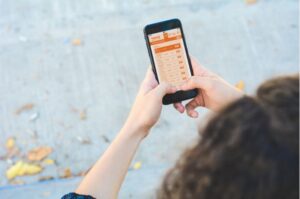 Download your airline’s app. That way, you'll be able to check in online and use your phone as your boarding pass.If you don’t want to do that, print your boarding pass at home before you leave.Either of these steps will let you skip the line at check-in counters. You can just drop off any bags you want to check in the bag-check area and be on your way to the security screening line.
Download your airline’s app. That way, you'll be able to check in online and use your phone as your boarding pass.If you don’t want to do that, print your boarding pass at home before you leave.Either of these steps will let you skip the line at check-in counters. You can just drop off any bags you want to check in the bag-check area and be on your way to the security screening line.- Check your airline’s website for specific guidelines or regulations regarding carry-on items, liquids, electronic devices, and medical equipment. You need to comply with these rules, or you’ll be delayed at the security checkpoint.
Sign up for Trusted Traveler Programs
U.S. Customs and Border Protection has several Trusted Traveler Programs that provide expedited security screening through dedicated lanes for low-risk travelers who want to avoid long lines at the security checkpoint. That's you!
TSA PreCheck®
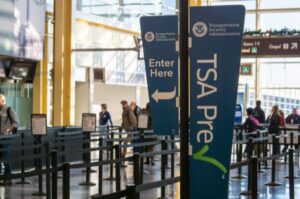 The TSA PreCheck program is administered by the Transportation Security Administration (TSA) to provide expedited security screening for people flying in the U.S. or to other countries from the U.S.
The TSA PreCheck program is administered by the Transportation Security Administration (TSA) to provide expedited security screening for people flying in the U.S. or to other countries from the U.S.
TSA says that about 99% of passengers wait in this shorter security line for less than 10 minutes. I've usually found that to be true.
How TSA PreCheck works
When you apply for TSA PreCheck, the TSA performs a background check. If you’re found to be a low-risk traveler, you’ll be assigned a Known Traveler Number (KTN) to use when you make your reservation.
If you have TSA PreCheck, you usually won’t have to remove your shoes, belt, or light jacket or take out your 3-1-1 liquids bag. You will still have to remove a heavy coat and your computer.
I say “usually” because the TSA Officers at the airport can change the rules at any time. For example, if there’s a known security threat, they may require you to take your shoes off and remove your 3-1-1 bag, even though you have PreCheck.
How to enroll in TSA PreCheck
There are more than 200 U.S. airports and 90 airlines participating. You can find out if your airport and airline participate on the TSA website here.
There are several options to enroll in TSA PreCheck. You'll need to make an in-person appointment for a short interview at an enrollment center. TSA PreCheck costs between $78 and $85, and you need to renew it every 5 years.
Expert advice
Check your boarding pass, either on your phone or on your paper copy. If you have TSA PreCheck, your boarding pass should say TSAPRECHK, TSA PRE, or TSA PreCheck. If it doesn't, visit the airline counter and find out what the problem is.
If your boarding pass doesn't have these identifiers, you won't be allowed into the TSA PreCheck line for expedited screening. If this happens frequently, check with TSA to sort out the problem.
Global Entry
Global Entry is a program managed by U.S. Customs and Border Protection.
Global Entry benefits include expedited clearance through immigration and customs at most international airports when you're returning to the United States from another country. The application fee is $100 and includes TSA PreCheck.
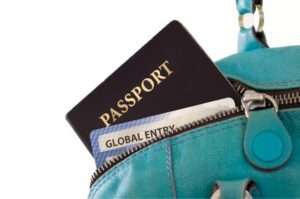 If you're planning on any international travel, Global Entry helps you speed through security whether you're leaving the U.S. (with TSA PreCheck) or returning from outside the U.S. When returning to the U.S., just look for the Global Entry kiosks when you reach immigration.
If you're planning on any international travel, Global Entry helps you speed through security whether you're leaving the U.S. (with TSA PreCheck) or returning from outside the U.S. When returning to the U.S., just look for the Global Entry kiosks when you reach immigration.
As with TSA PreCheck, you need to be pre-approved for the Global Entry program. This includes a background check and an in-person interview. Processing time can be as long as 6 months so if this is of interest to you, apply now.
Mobile Passport Control
Mobile Passport Control (MPC) is an app for Apple and Android offered by U.S. Customs and Border Protection.
If you’re entering the U.S. at a designated airport, you can submit your photo, passport information, and customs declaration on your phone. This means you get through passport control and customs more quickly. If you have this, you won’t have to complete a paper form, and depending on the airport, there may be an MPC line that is shorter.
CLEAR Plus
If you travel a lot, CLEAR Plus may be useful to you. If you’re a member of CLEAR Plus, you go through a separate security line and use a CLEAR kiosk to verify your identity with biometric data (an iris or fingerprint scan) rather than wait in line for a TSA agent to verify your identity.
You’ll still have to go through security screening, but you’ll be in an expedited security line and you'll at least save time by not waiting in the first line to have your ID checked. CLEAR membership costs $189 per year.
Other Programs for Frequent Travelers
- NEXUS. If you travel frequently between the U.S. and Canada, you might be interested in NEXUS to speed your time crossing the border. It costs $50 for 5 years. Processing time is 12-14 months.
- Sentri. Sentri provides expedited entry into the U.S. from either Canada or Mexico. Processing time is 10-12 months
You can start the application process for any of these Trusted Traveler Programs here.
Expert advice
- Check your credit card. Some credit cards reimburse the application fees for Trusted Traveler Programs.
- You may also get priority access to screening lines if you are flying first- or business-class or have airline elite status as part of a frequent flyer program. Check with your airline.
Pack Smart
To speed through the airport security line, you’ll need to be able to fish things out of your bags quickly, so start with a well-organized carry-on bag.
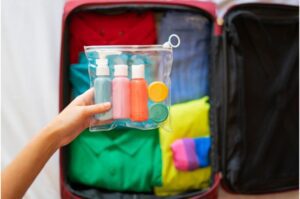 This means opting for travel-sized toiletries that comply with TSA’s 3-1-1 rule and placing those toiletries together in one quart-sized clear plastic bag.
This means opting for travel-sized toiletries that comply with TSA’s 3-1-1 rule and placing those toiletries together in one quart-sized clear plastic bag.
If you’re traveling with a laptop, tablet, game consoles, e-readers, etc., be sure they’re easy to get to, as you’ll need to take them out of your bag when going through screening.
Pack your carry-on luggage in a way that minimizes the need to rummage through your bag at security checkpoints.
Keep documents like boarding passes and your ID easily accessible.
Expert advice
Get a passport holder with a neck strap. These often contain a place for your U.S. ID, a boarding pass, some cash, and other essential information.
You definitely don’t want to lose your ID, and it’s easy to set it down someplace and walk off, especially after a long, international flight. Shall I tell you about the time I left my passport in the bathroom in Bangkok? OK, I'll save that for another time.
READ MORE >>> Rightsize Your Travel Toiletries: Best Solutions for 2024
Dress Appropriately
Wear shoes that are easy to remove and put back on. A lot of people recommend slip-on shoes. Great idea if they stay on when you need them to.
I suggest you think twice about slip-on slides and flip-flops, though. How are they going to work for you in case you need to move in a hurry? I don't know about you, but I want something that will stay on my feet in case there's an emergency.
If you’re wearing high heels or boots and they have a metal shaft in them, take them off and put them on the belt, even if you have TSA PreCheck. Don’t wear them through the metal detector. If you set it off, you’ll have to go through it again, all while dealing with the daggers being thrown at you by the passengers behind you.
Also, avoid excessive jewelry or clothes with a lot of metal accents so you can avoid setting off the metal detector. If you want to wear it on the flight, pack it away while you go through screening, then put it on after.
And if you’re wearing outer layers, be sure they’re easy and quick to remove and put back on.
Arrive at the Right Time
The best time to arrive at the airport is in plenty of time to relax before your flight. Hey! It’s a vacation. No point in creating extra stress. So think at least 2 hours for domestic flights and 3 for international flights.
You can often minimize wait times at security checkpoints if you arrive at the right time. Consider these strategies:
-
 Arrive at the airport during off-peak hours when security lines are typically shorter. This means early mornings (after the 5-7 AM business rush has died down) or late in the evenings.
Arrive at the airport during off-peak hours when security lines are typically shorter. This means early mornings (after the 5-7 AM business rush has died down) or late in the evenings.- Avoid peak travel times like holidays and weekends. Airports are busiest then, and security lines are longer.
- Use mobile apps like MiFlight, Kayak, App in the Air, and MyTSA app. These all predict the average wait time at TSA checkpoints. Many of them also allow you to track flight status, and they provide airport maps so you can find your gate as well as shops and restaurants.
Familiarize Yourself With the Security Screening Process
Nothing annoys experienced travelers more than standing behind someone in the security line who has to toss a water bottle, empty their pocket of change, dig in their handbag to find their passport and phone, search through their luggage to find their liquids, dig in another bag for their computer, then repeat the process at the other end to put everything away.
Don’t be that person!
If you are that person, you will NOT be breezing through security.
Before you get to the security checkpoint
If you want to get through airport security faster, toss your coffee or tea and empty your water bottle before you get to the security gate. There will be a trash can and recycling bin somewhere in the vicinity.
Savvy travelers use the Big Bag/Little Bag approach:
- Bring along a Big Bag you can fold up in your carry-on to use later for shopping, laundry, etc., and place a small zip-lock bag (the Little Bag) inside it before you leave home.
- Before you enter the security line, take everything out of your pockets and put it in the Little Bag. Place the LIttle Bag back in the Big Bag. “Everything” means everything unless you’re looking for a pat-down from the security officer.
- Add your 3-1-1 toiletry bag, your phone, and anything that might set off the metal detector, such as a belt, jewelry, metal glasses, etc., to the Big Bag.
- Keep your ID and boarding pass out and available to show the TSA officer.
- As you’re waiting in line, read any signs that will let you know what clothes you need to take on or off and what you need to take out of your bag so that you’re prepared.
What to do in the security line
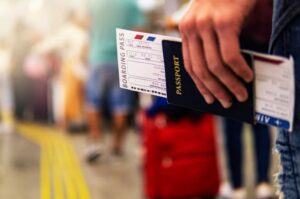 If you’ve done all this, you’ll enter the security line with your carry-on item, your personal item if you’re taking one, and the Big Bag with all the small things safely tucked inside in the Little Bag. Have your ID and your boarding pass in your hand or in an easy-to-reach pocket.
If you’ve done all this, you’ll enter the security line with your carry-on item, your personal item if you’re taking one, and the Big Bag with all the small things safely tucked inside in the Little Bag. Have your ID and your boarding pass in your hand or in an easy-to-reach pocket.
- Once you get to the front of the line, the TSA officer will ask to see your ID and boarding pass. Once they’ve checked that everything matches, put those items in the Big Bag.
- When you get to the conveyor belt, put your carry-on and personal bags on the conveyor belt or in a bin if requested.
- Put your laptop and any other electronic devices bigger than a phone in another bin. Nothing else goes in the bin with the electronics, and the devices can’t be on top of each other.
- Put your 3-1-1 bag in another bin with the Big Bag (the one with all the other things) in its own bin. Just be sure they aren’t piled on top of each other.
- If you have to take off your shoes, a light jacket, or a coat, put those in another bin. The nice thing about putting your shoes last is that you won’t walk off with anything left on the belt.
If you have any questions about what to do, there will be TSA agents at the conveyor belt who can help.
After you’ve made it through security screening
Once you’re safely through security screening, grab your carry-on bag and personal item, scoop up everything else into the Big Bag, and walk away.
Find the nearest place where you can sit down and put everything back together. Take your time and double-check to be sure you've collected everything. If not, you’ll be right near the security gate and can go back and get it.
Follow this process, and you’ll get through security fast, without stress, and without leaving anything behind.
Special Screening for People with Disabilities, Those 75+, and Others
Passengers 75 and older may get expedited screening. In this case, you may be able to leave your shoes on, although if anything sets off the metal detector, you’ll be required to remove them.
If you’re unable to stand for screening, don't worry. The TSA has other screening methods they can rely on. I broke my femur out hiking and had to travel in a wheelchair. I had to remove whatever was in my pockets, then they pushed me through the gate, and a TSA agent waived a wand over my torso and patted down my legs and arms. Easy-peasy.
If you have a disability or you’re traveling with medications, medical devices, or implants, need a wheelchair or respiratory equipment, have a service animal, etc., the TSA has special accommodations. You can learn about them here.
Conclusion
The key to a relaxing holiday is planning ahead. No point panicking because you think you'll miss your flight. Just show up in plenty of time. Airports have shops, restaurants, and bars. Read a book. Watch the people.
Plan ahead, pack and dress appropriately, and follow the steps above. That way, you can run the gauntlet of airport security and get to your gate quickly and with minimum stress. And if you remember the Big Bag/Little Bag trick, you won’t leave anything behind.
I know some of you dear readers have your own tips and tricks to get through airport security faster. Please leave them below so we can all learn from each other. I wish you safe travels. 🧳🏝️🛩️
👋 But wait! Before you go, check out these other posts to help you plan and pack for your trip.
How to Pack Your Electronics for Travel: Best Tips for 2024
What Travel Documents Do You Need for an International Trip?
35+ Expert Travel Packing Tips to Reduce Packing Stress
For more travel tips, sign up for Coffee and Compass, the Smart Travel Guide's weekly newsletter. Just grab a cuppa and get ready to immerse yourself in the wonderful world of travel.
Pin this post to read later
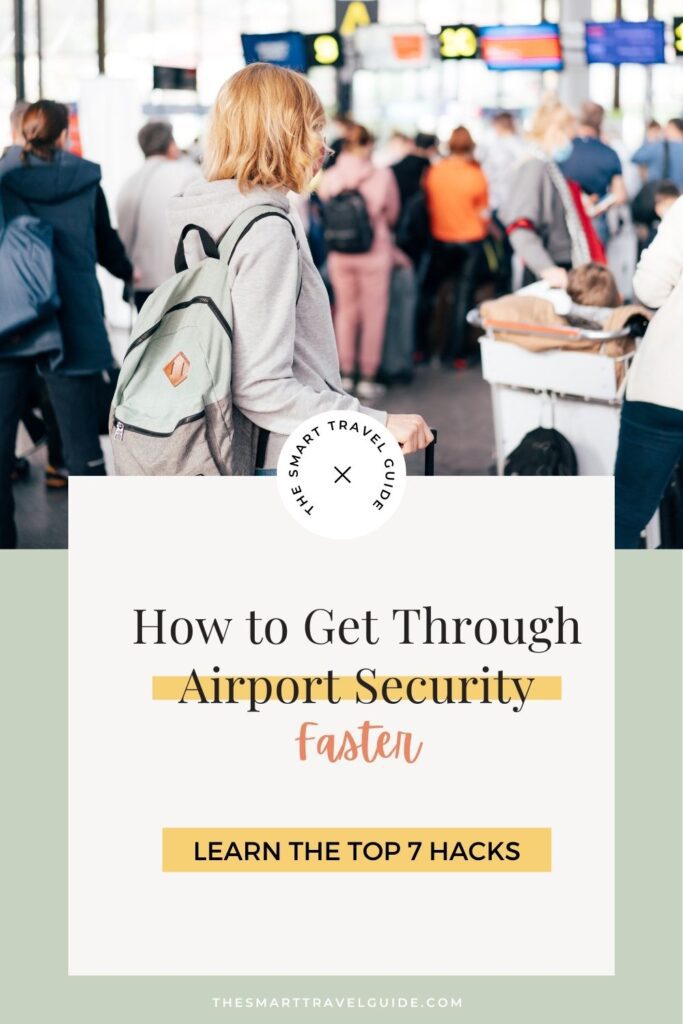
- About the Author
- Latest Posts
Peggy is a retired entrepreneur and world traveler, now happily traveling in the second half of life. She’s flown over 2 million miles and spent time in 48 states and 50+ countries, much of this since she turned 50. Read the About page to learn more about Peggy and why she started The Smart Travel Guide 10 years after retiring. If you want to send Peggy a brief message, visit her contact page.
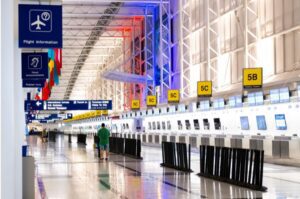 Arrive at the airport during off-peak hours when security lines are typically shorter. This means early mornings (after the 5-7 AM business rush has died down) or late in the evenings.
Arrive at the airport during off-peak hours when security lines are typically shorter. This means early mornings (after the 5-7 AM business rush has died down) or late in the evenings.
Be the first to comment